Relative Importance of Land Use and Climate Change on Hydrology in Agricultural Watershed of Southern China
Abstract
1. Introduction
2. Materials and Methods
2.1. Study Area
2.2. Data
2.2.1. Soil Data
2.2.2. Land Use Data
2.2.3. Weather Data
2.2.4. Discharge Data
2.3. SWAT Model Description and Parameterization
2.4. Parameter Calibration and Validation
2.5. Differentiation of Effects of Land Use and Climate Changes on Runoff
3. Results
3.1. Model Sensitivity, Calibration, and Validation
3.2. Effect of Land Use Change on Runoff
3.3. Impact of Climate Change on Runoff
3.4. Runoff Response to Land Use and Climate Changes
4. Discussion
5. Conclusions
Author Contributions
Funding
Conflicts of Interest
References
- Intergovernmental Panel on Climate Change, IPCC. Climate Change 2014: Synthesis Report. Contribution of Working Groups I, II and III to the Fifth Assessment Report of the Intergovernmental Panel on Climate Change; IPCC: Geneva, Switzerland, 2014. [Google Scholar]
- Zhang, J.Y.; Zhang, S.L.; Wang, J.X.; Li, Y. Study on runoff trends of the six larger basins in China over the past 50 years. Adv. Water Sci. 2007, 18, 230–234. (In Chinese) [Google Scholar]
- Zhai, R.; Tao, F. Contributions of climate change and human activities to runoff change in seven typical catchments across China. Sci. Total. Environ. 2017, 605–606, 219–229. [Google Scholar] [CrossRef] [PubMed]
- Ward, P.J.; Renssen, H.; Aerts, J.C.J.H.; Van Balen, R.T.; Vandenberghe, J. Strong increases in flood frequency and discharge of the River Meuse over the late Holocene: Impacts of long-term anthropogenic land use change and climate variability. Hydrol. Earth Syst. Sci. 2008, 12, 159–175. [Google Scholar] [CrossRef]
- Wang, G.; Xia, J.; Chen, J. Quantification of effects of climate variations and human activities on runoff by a monthly water balance model: A case study of the Chaobai River Basin in northern China. Water Resour. Res. 2009, 45, 206–216. [Google Scholar] [CrossRef]
- Awotwi, A.; Anornu, G.K.; Quayeballard, J.; Annor, T.; Forkuo, E.K. Analysis of climate and anthropogenic impacts on runoff in the Lower Pra River Basin of Ghana. Heliyon 2017, 3, e00477. [Google Scholar] [CrossRef]
- Fohrer, N.; Haverkamp, S.; Eckhardt, K.; Frede, H.G. Hydrologic response to land use changes on the catchment scale. Phys. Chem. Earth Part B Hydrol. Ocean. Atmos. 2001, 26, 577–582. [Google Scholar] [CrossRef]
- Feddema, J.J.; Oleson, K.W.; Bonan, G.B.; Mearns, L.O.; Buja, L.E.; Meehl, G.A.; Washington, W.M. The importance of land-cover change in simulating future climates. Science 2005, 310, 1674–1678. [Google Scholar] [CrossRef]
- Guzha, A.C.; Rufino, M.C.; Okoth, S.; Jacobs, S.; Nóbrega, R.L.B. Impacts of land use and land cover change on surface runoff, discharge and low flows: Evidence from East Africa. J. Hydrol. Reg. Stud. 2018, 15, 49–67. [Google Scholar] [CrossRef]
- Sun, Z.D.; Lotz, T.; Chang, N.B. Assessing the long-term effects of land use changes on runoff patterns and food production in a large lake watershed with policy implications. J. Environ. Manag. 2017, 204, 92–101. [Google Scholar] [CrossRef]
- Jia, J.; Shi, X.L. Impacts of land use/land cover change on the runoff of Qinhuangdao area. Geogr. Geo Inf. Sci. 2017, 33, 108–114. (In Chinese) [Google Scholar]
- Sunde, M.G.; He, H.S.; Hubbart, J.A.; Urban, M.A. An integrated modeling approach for estimating hydrologic responses to future urbanization and climate changes in a mixed-use midwestern watershed. J. Environ. Manag. 2018, 220, 149–162. [Google Scholar] [CrossRef] [PubMed]
- Wu, F.; Zhan, J.; Güneralp, I. Present and future of urban water balance in the rapidly urbanizing Heihe River basin, northwest China. Ecol. Model. 2015, 318, 254–264. [Google Scholar] [CrossRef]
- Ozdemir, H.; Elbasi, E. Benchmarking land use change impacts on direct runoff in ungauged urban watersheds. Phys. Chem. Earth Parts A B C 2015, 79–82, 100–107. [Google Scholar] [CrossRef]
- Chien, H.; Yeh, J.F.; Knouft, J.H. Modeling the potential impacts of climate change on streamflow in agricultural watersheds of the Midwestern United States. J. Hydrol. 2013, 491, 73–88. [Google Scholar] [CrossRef]
- Zhao, Y.F.; Zou, X.Q.; Gao, J.H.; Xu, X.W.H.; Wang, C.L.; Tang, D.H.; Wang, T.; Wu, X.W. Quantifying the anthropogenic and climatic contributions to changes in water discharge and sediment load into the sea: A case study of the Yangtze River, China. Sci. Total. Environ. 2015, 536, 803–812. [Google Scholar] [CrossRef] [PubMed]
- Chang, H. Basin Hydrologic Response to Changes in Climate and Land Use: The Conestoga River Basin. J. Phys. Geogr. 2003, 24, 222–247. [Google Scholar] [CrossRef]
- Muyibul, Z.; Shi, Q.D.; Muhtar, P.; Zhang, R. Land use and climate change effects on runoff in the upper Urumqi River watershed: A SWAT model based analysis. Acta Ecol. Sin. 2018, 38, 5149–5157. (In Chinese) [Google Scholar]
- Fontaine, T.A.; Klassen, J.F.; Cruickshank, T.S.; Hotchkiss, R.H. Hydrological response to climate change in the Black Hills of South Dakota, USA. Int. Assoc. Sci. Hydrol. Bull. 2001, 46, 27–40. [Google Scholar] [CrossRef]
- Wang, S.J.; Yan, M.; Yan, Y.X.; Shi, C.X.; Li, H. Contributions of climate change and human activities to the changes in runoff increment in different sections of the Yellow River. Quat. Int. 2012, 282, 66–77. [Google Scholar] [CrossRef]
- Dai, W.; Lv, D.Q.; Li, J.B.; Wang, J.F. The effect of climate change and human activities on runoff in the middle reaches of the Yangtze River. J. Glaciol. Geocryol. 2016, 38, 488–497. (In Chinese) [Google Scholar]
- Liu, G.H.; Qi, S.H.; Zhu, J.X.; Xiong, M.Y.; Wang, D. Quantitative estimation of runoff changes in Ganjiang River, Lake Poyang Basin under climate change and anthropogenic impacts. J. Lake Sci. 2016, 28, 682–690. (In Chinese) [Google Scholar]
- Calder, I.R.; Hall, R.L.; Bastable, H.G.; Gunston, H.M.; Shela, O.; Chirwa, A.; Kafundu, R. The impact of land use change on water resources in sub-Saharan Africa: A modeling study of Lake Malawi. J. Hydrol. 1995, 170, 123–135. [Google Scholar] [CrossRef]
- Lorup, J.K.; Refsgaard, J.C.; Mazvimavi, D. Assessing the effect of land use change on catchment runoff by combined use of statistical tests and hydrological modeling: Case studies from Zimbabwe. J. Hydrol. 1998, 205, 147–163. [Google Scholar] [CrossRef]
- Muttiah, R.S.; Wurbs, R.A. Scale-dependent soil and climate variability effects on watershed water balance of the SWAT model. J. Hydrol. 2002, 256, 264–285. [Google Scholar] [CrossRef]
- Cao, W.Z.; Bowden, W.B.; Davie, T.; Fenemor, A. Multi-variable and multi-site calibration and validation of SWAT in a large mountainous catchment with high spatial variability. Hydrol. Process. 2006, 20, 1057–1073. [Google Scholar] [CrossRef]
- Yan, T.; Bai, J.; Lee Zhi Yi, A.; Shen, Z. SWAT-Simulated Streamflow Responses to Climate Variability and Human Activities in the Miyun Reservoir Basin by Considering Streamflow Components. Sustainability 2018, 10, 941. [Google Scholar] [CrossRef]
- Chiang, L.; Chaubey, I.; Gitau, M.W.; Arnold, J.G. Differentiating impacts of land use changes from pasture management in a CEAP watershed using the SWAT model. Trans. Asabe 2010, 53, 1569–1584. [Google Scholar] [CrossRef]
- Nie, W.; Yuan, Y.; Kepner, W.; Nash, M.S.; Jackson, M.; Erickson, C. Assessing impacts of landuse and landcover changes on hydrology for the upper San Pedro watershed. J. Hydrol. 2011, 407, 105–114. [Google Scholar] [CrossRef]
- Lotz, T.; Opp, C.; He, X. Factors of runoff generation in the Dongting Lake basin based on a SWAT model and implications of recent land cover change. Quat. Int. 2017, 475, 54–62. [Google Scholar] [CrossRef]
- Thavhana, M.P.; Savage, M.J.; Moeletsi, M.E. SWAT model uncertainty analysis, calibration and validation for runoff simulation in the Luvuvhu river catchment, South Africa. Phys. Chem. Earth Parts A B C 2018, 105, 115–124. [Google Scholar] [CrossRef]
- Chaplot, V. Water and soil resources response to rising levels of atmospheric CO2 concentration and to changes in precipitation and air temperature. J. Hydrol. 2007, 337, 159–171. [Google Scholar] [CrossRef]
- Ghaffari, G.; Keesstra, S.; Ghodousi, J.; Ahmadi, H. SWAT-simulated hydrological impact of land-use change in the Zanjanrood basin, Northwest Iran. Hydrol. Process. 2010, 24, 892–903. [Google Scholar] [CrossRef]
- Lin, B.; Chen, X.; Yao, H.; Chen, Y.; Liu, M.; Gao, L.; James, A. Analyses of land use change impacts on catchment runoff using different time indicators based on SWAT model. Ecol. Indic. 2015, 58, 55–63. [Google Scholar] [CrossRef]
- Li, J.; Li, G.; Zhou, S.; Chen, F. Quantifying the effects of land surface change on annual runoff considering precipitation variability by SWAT. Water Resour Manag. 2016, 30, 1071–1084. [Google Scholar] [CrossRef]
- Luan, X.B.; Wu, P.T.; Sun, S.K.; Li, X.L.; Wang, Y.B.; Gao, X.R. Impact of land use change on hydrologic processes in a large plain irrigation district. Water Resour Manag. 2018, 32, 3203–3217. [Google Scholar] [CrossRef]
- Jiang, X.F.; Wang, L.; Ma, F.; Li, H.Q.; Zhang, S.J.; Liang, X.W. Localization method for SWAT model soil database based on HWSD. China Water Wastewater 2014, 30, 135–138. (In Chinese) [Google Scholar]
- Li, Y.Y.; Chang, J.X.; Luo, L.F.; Wang, Y.M.; Guo, A.J.; Ma, F.; Fan, J.J. Spatiotemporal impacts of land use land cover changes on hydrology from the mechanism perspective using SWAT model with time-varying parameters. Hydrol. Res. 2018, 50, 244–261. [Google Scholar] [CrossRef]
- Winchell, M. ArcSWAT 2009 User Manual; Yellow River Water Conservancy Press: Jiangsu, China, 2012. [Google Scholar]
- Xue, F.; Shi, P.; Qu, S.M.; Wang, J.J.; Zhou, Y.M. Evaluating the impact of spatial variability of precipitation on streamflow simulation using a SWAT model. Water Policy Corrected Proof 2018, 21, 178–196. [Google Scholar] [CrossRef]
- Liu, X.; Yang, M.X.; Meng, X.Y.; Wen, F.; Sun, G.D. Assessing the Impact of reservoir parameters on runoff in the Yalong River Basin using the SWAT model. Water 2019, 11, 643. [Google Scholar] [CrossRef]
- Geza, M.; McCray, J.E. Effects of soil data resolution on SWAT model stream flow and water quality predictions. J. Environ. Manag. 2008, 88, 393–406. [Google Scholar] [CrossRef]
- Luo, Q.; Wang, K.L.; Wang, Q.X. Using SWAT to simulate runoff under different land use scenarios in Xiangjiang River Basin. Chin. J. Eco Agric. 2011, 19, 1431–1436. (In Chinese) [Google Scholar] [CrossRef]
- Du, J.; He, F.; Zhang, Z.; Shi, P.J. Precipitation change and human impacts on hydrologic variables in Zhengshui River Basin, China. Stoch. Environ. Res. Risk Assess. 2011, 25, 1013–1025. [Google Scholar] [CrossRef]
- He, F.; Fang, W.H.; Shi, P.J.; Zheng, J.; Chen, B.; Xu, H. Modeling effect of reservoir on hydrological processes in the Zhengshui River basin of Xiangjiang River, China. In Proceedings of the International Disaster Reduction Conference, Harbin, China, 21–25 August 2007; pp. 442–446. [Google Scholar]
- Luo, L.H.; Xie, H.X.; Ning, M.J.; Zhang, M.; He, H.S.; Li, Y.P. Variation Trend of Runoff in Zhengshui River Watershed from 1961 to 2012. J. Yangtze River Sci. Res. Inst. 2019, 36, 42–48. (In Chinese) [Google Scholar]
- Saxton, K.E.; Willey, P.H. Agricultural wetland and pond hydrologic analyses using the SPAW Model. In Proceedings of the 2004 Self-Sustaining Solutions for Streams, Wetlands, and Watersheds Conference, St. Joseph, MI, USA, 12–15 September 2004. [Google Scholar]
- Arnold, J.G.; Srinisvan, R.; Muttiah, R.S.; Williams, J.R. Large area hydrologic modeling and assessment, part I: Model development. J. Am. Water Resour. 1998, 34, 73–78. [Google Scholar] [CrossRef]
- Gassman, P.W.; Reyes, M.R.; Green, C.H.; Arnold, J.G. The Soil and Water Assessment Tool: Historical development, applications and future directions. Trans. ASABE 2007, 50, 1211–1250. [Google Scholar] [CrossRef]
- Ahmadi, M.; Moeini, A.; Ahmadi, H.; Motamedvaziri, B.; Zehtabiyan, G.R. Comparison of the Performance of SWAT, IHACRES and Artificial Neural Networks models in rainfall-runoff simulation (Case study: Kan watershed, Iran). Phys. Chem. Earth 2019, 111, 65–77. [Google Scholar] [CrossRef]
- SCS National Engineering Handbook, Section 4: Hydrology, Soil Conservation Service; USDA: Washington, DC, USA, 1972.
- Neitsch, S.; Arnold, J.; Kiniry, J.; Williams, J. Soil and Water Assessment Tool theoretical documentation, Version 2009. In Texas Water Resources Institute Technical Report No.406; Texas A&M University System: College Station, TX, USA, 2011. [Google Scholar]
- Arnold, J.G.; Moriasi, D.N.; Gassman, P.W.; Abbaspour, K.C.; White, M.J.; Srinivasan, R.; Santhi, C.; Harmel, D.; Van Griensven, A.; Van Liew, M.W.; et al. SWAT: Model use, calibration, and validation. Biol. Syst. Eng. Pap. Publ. 2012. [Google Scholar] [CrossRef]
- Faramarzi, M.; Abbaspour, K.C.; Schulin, R.; Yang, H. Modelling blue and green water resources availability in Iran. Hydrol. Process. 2009, 23, 486–501. [Google Scholar] [CrossRef]
- Niu, L.Q. The Study Based on the SWAT Model about the Climate and Landuse Change Affected on the Runoff-Set the Du River as an Example. Master’s Thesis, Central China Normal University, Wuhan, Hubei Province, China, 2013. (In Chinese). [Google Scholar]
- Coffey, M.E.; Workman, S.R.; Taraba, J.L.; Fogle, A.W. Statistical procedures for evaluating daily and monthly hydrologic model predictions. Trans. ASABE 2004, 47, 59–68. [Google Scholar] [CrossRef]
- Engel, B.; Storm, D.; White, M.; Arnold, J.; Arabi, M. A hydrologic/water quality model application protocol. J. Am. Water Resour. Assoc. 2007, 43, 1223–1236. [Google Scholar] [CrossRef]
- Liu, W. Hydrological Simulation and Runoff Response Analysis Based on SWAT Model: A Case Study of Weihe River in Guanzhong Area. Ph.D. Thesis, Northwest University, Xi’an, Shaanxi Province, China, 2014. (In Chinese). [Google Scholar]
- Abbaspour, K.C. User Manual for SWAT-CUP, SWAT Calibration and Uncertainty Analysis Programs; Swiss Federal Institute of Aquatic Science and Technology Eawag: Duebendorf, Switzerland, 2007; p. 93. [Google Scholar]
- Wang, X.X.; Melesse, A.M. Effects of statsgo and ssurgo as inputs on SWAT model’s snowmelt simulation1. J. Am. Water Resour. Assoc. 2006, 42, 20. [Google Scholar] [CrossRef]
- Romanowicz, A.A.; Vanclooster, M.; Rounsevell, M.; Junesse, I.L. Sensitivity of the SWAT model to the soil and land use data parameterization: A case study in the Thyle catchment, Belgium. Ecol. Model. 2005, 187, 27–39. [Google Scholar] [CrossRef]
- Ouyang, W.; Cai, G.Q.; Huang, H.B.; Hao, F.H. Optimization of key parameters for SWAT model based on field soil observation. J. Agro Environ. Sci. 2014, 33, 1601–1608. (In Chinese) [Google Scholar]
- Farsi, N.; Mahjouri, N. Evaluating the Contribution of the Climate Change and Human Activities to Runoff Change under Uncertainty. J. Hydrol. 2019, 574, 872–891. [Google Scholar] [CrossRef]
- Zhang, L.M.; Meng, X.Y.; Wang, H.; Yang, M.X. Simulated runoff and sediment yield responses to land-use change using the SWAT model in Northeast China. Water 2019, 11, 915. [Google Scholar] [CrossRef]
- Xia, Z.H.; Zhou, Y.H.; Xu, H.M. Water resources responses to climate changes in Hanjiang River basin based on SWAT model. Resour. Environ. Yangtze Basin 2010, 19, 158–163. (In Chinese) [Google Scholar]
- Islam, A.; Sikka, A.K.; Saha, B.; Singh, A. Streamflow response to climate change in the Brahmani River Basin, India. Water Resour. Manag. 2012, 26, 1409–1424. [Google Scholar] [CrossRef]
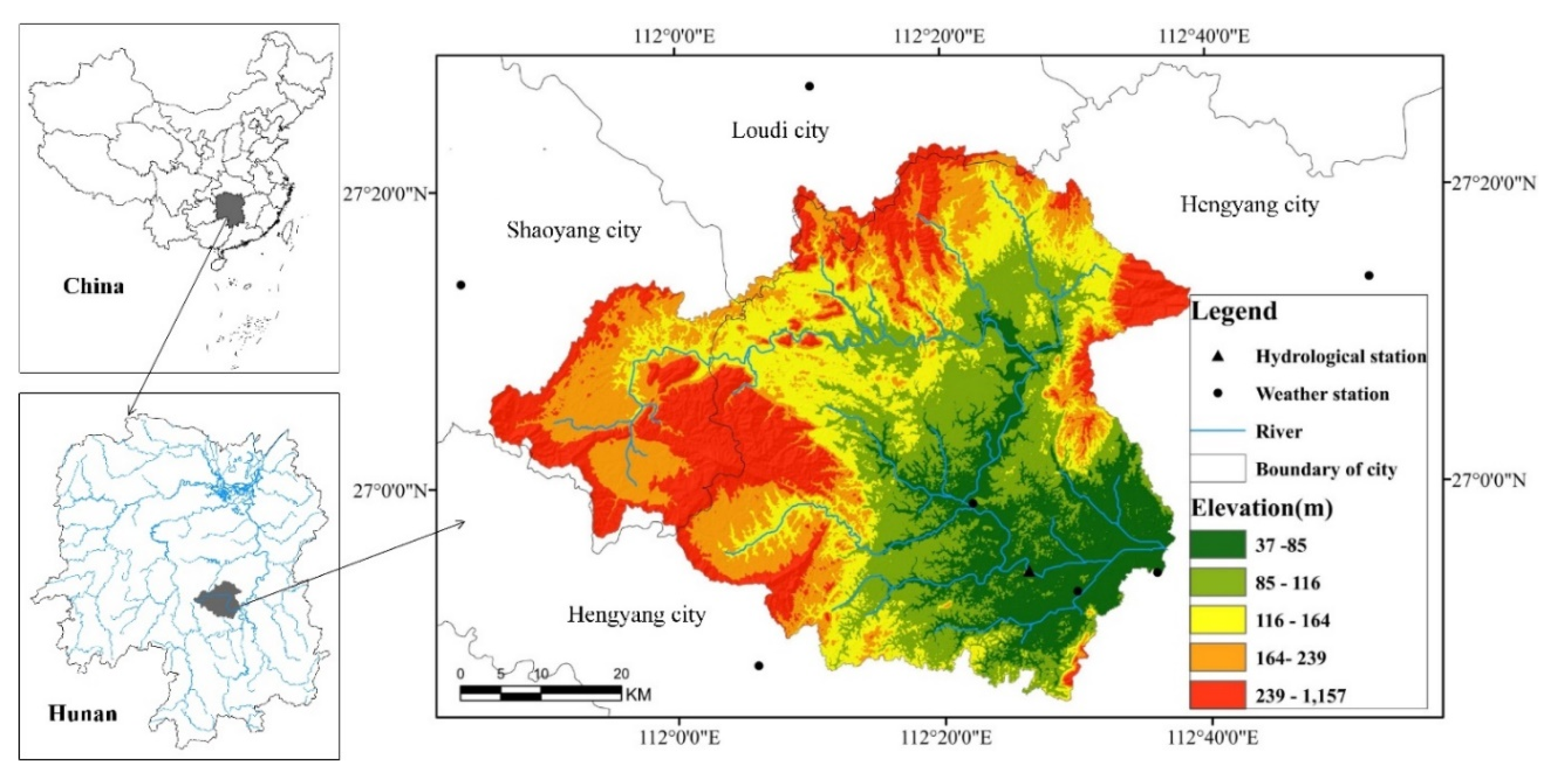

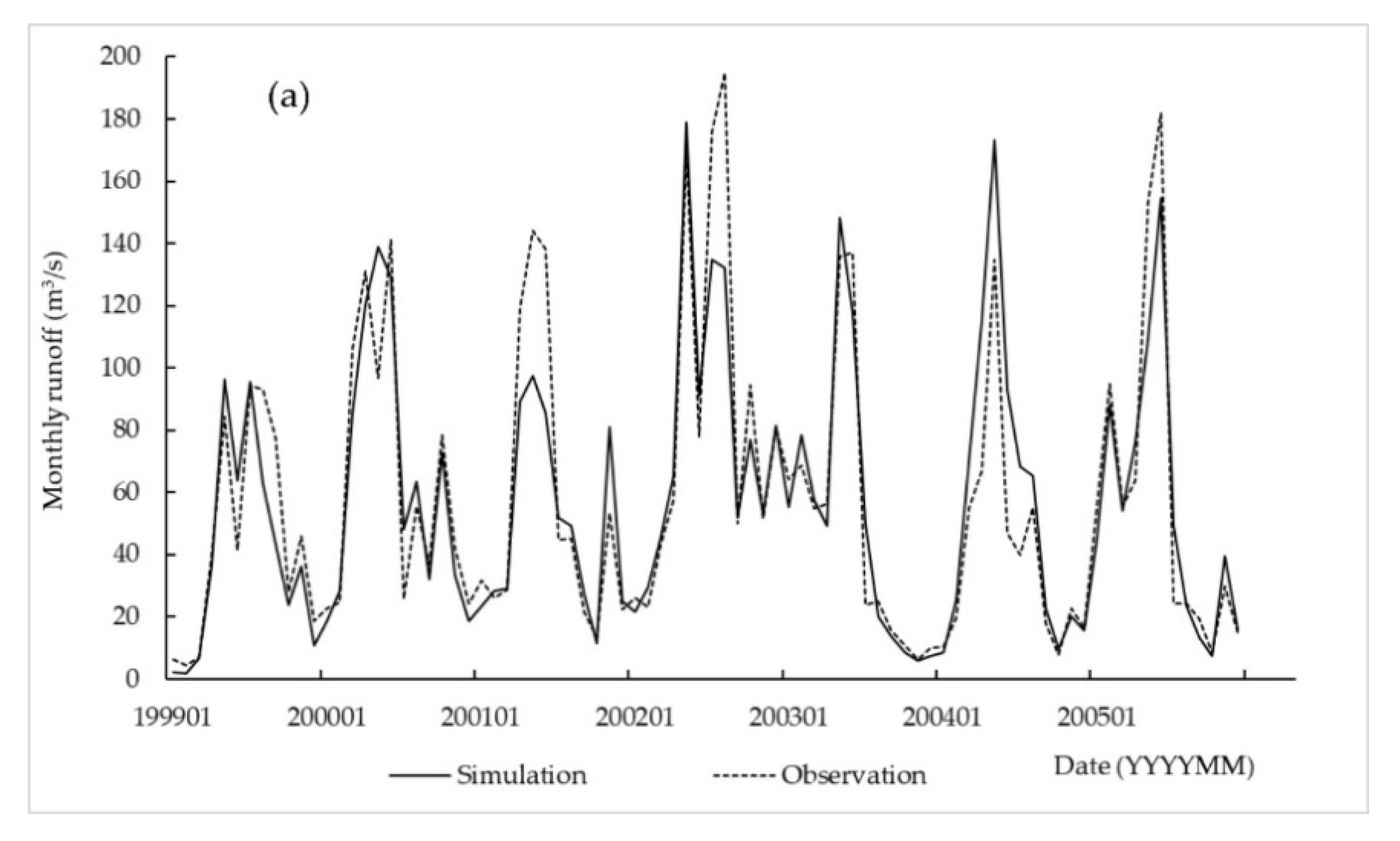
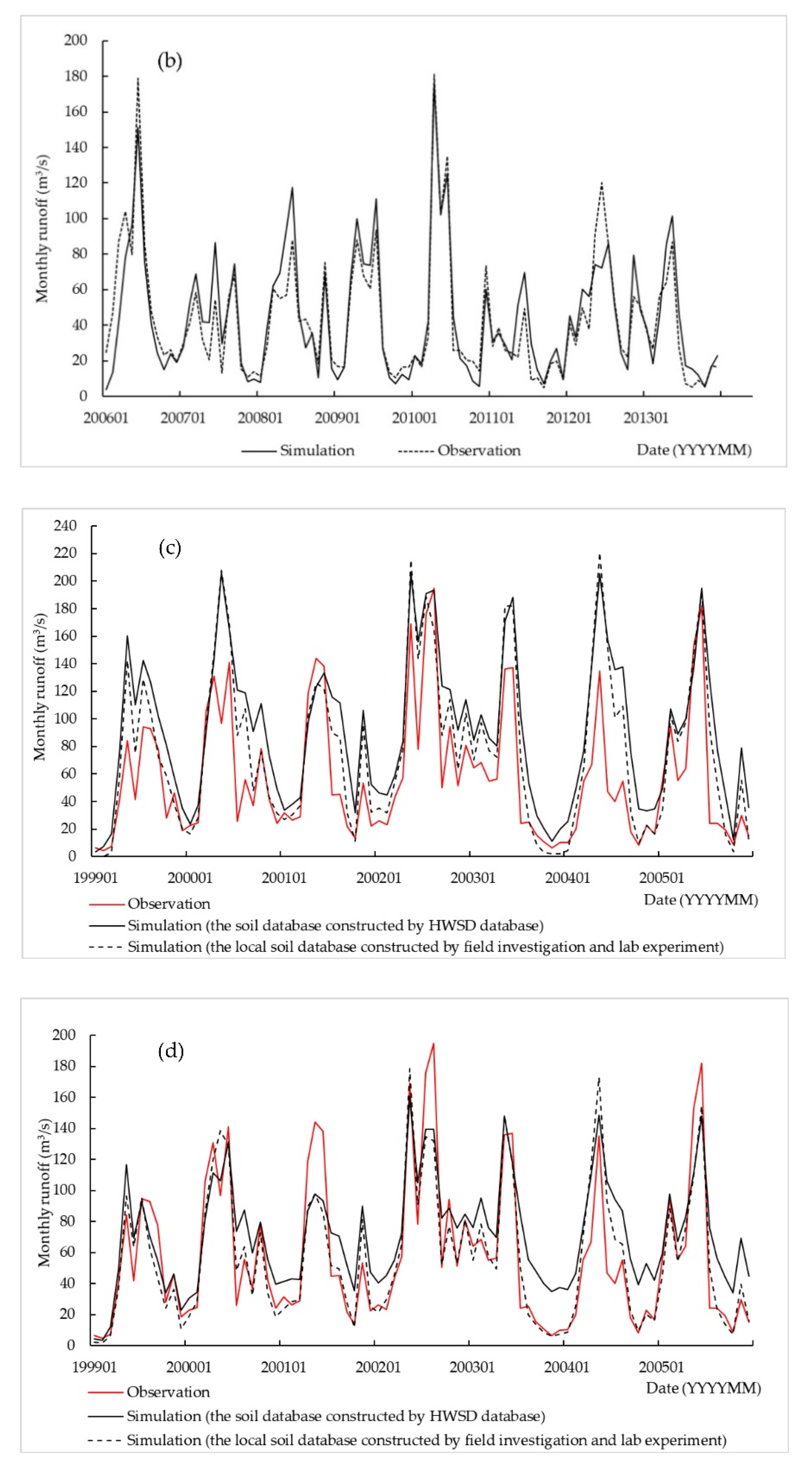
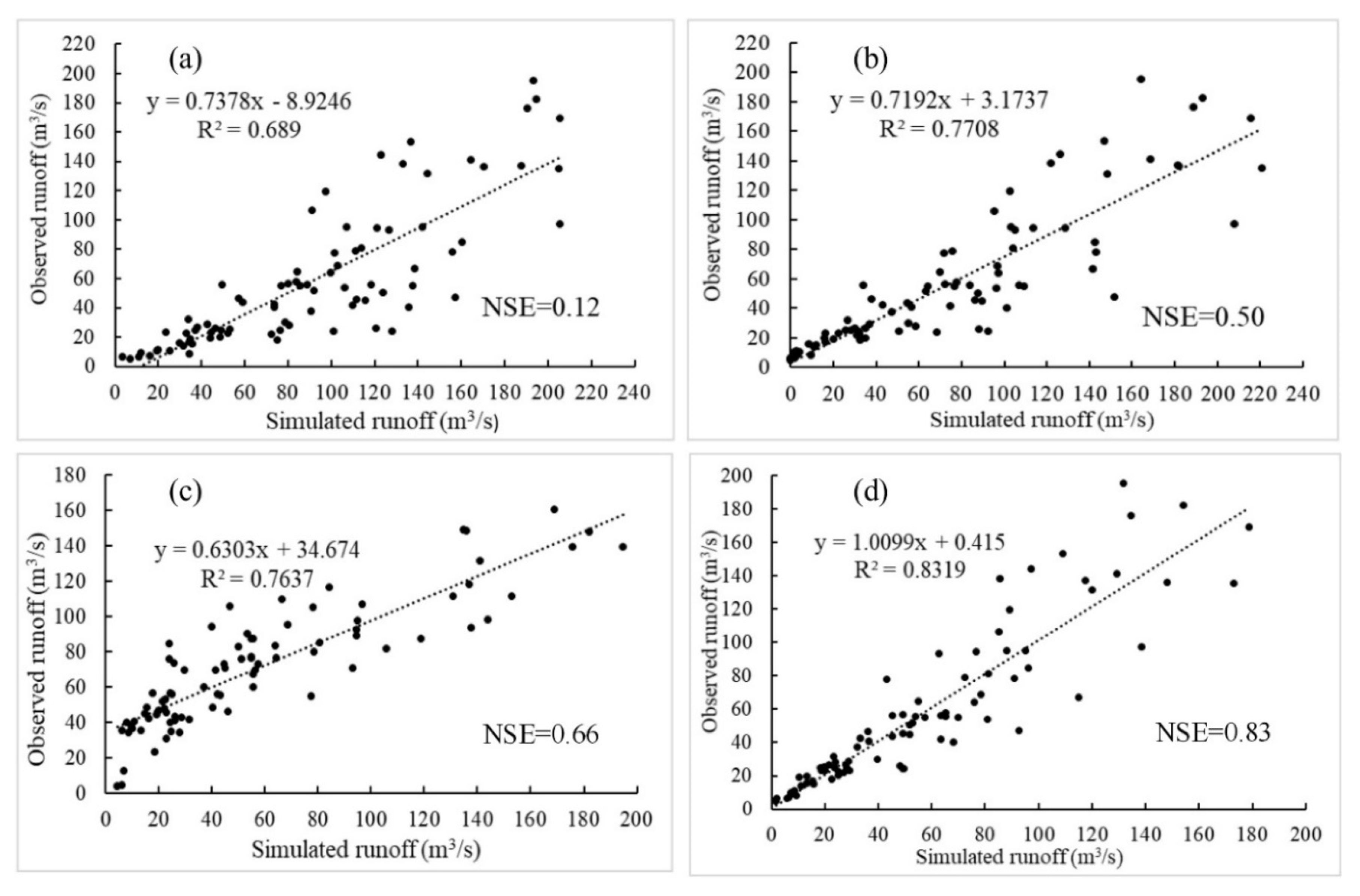
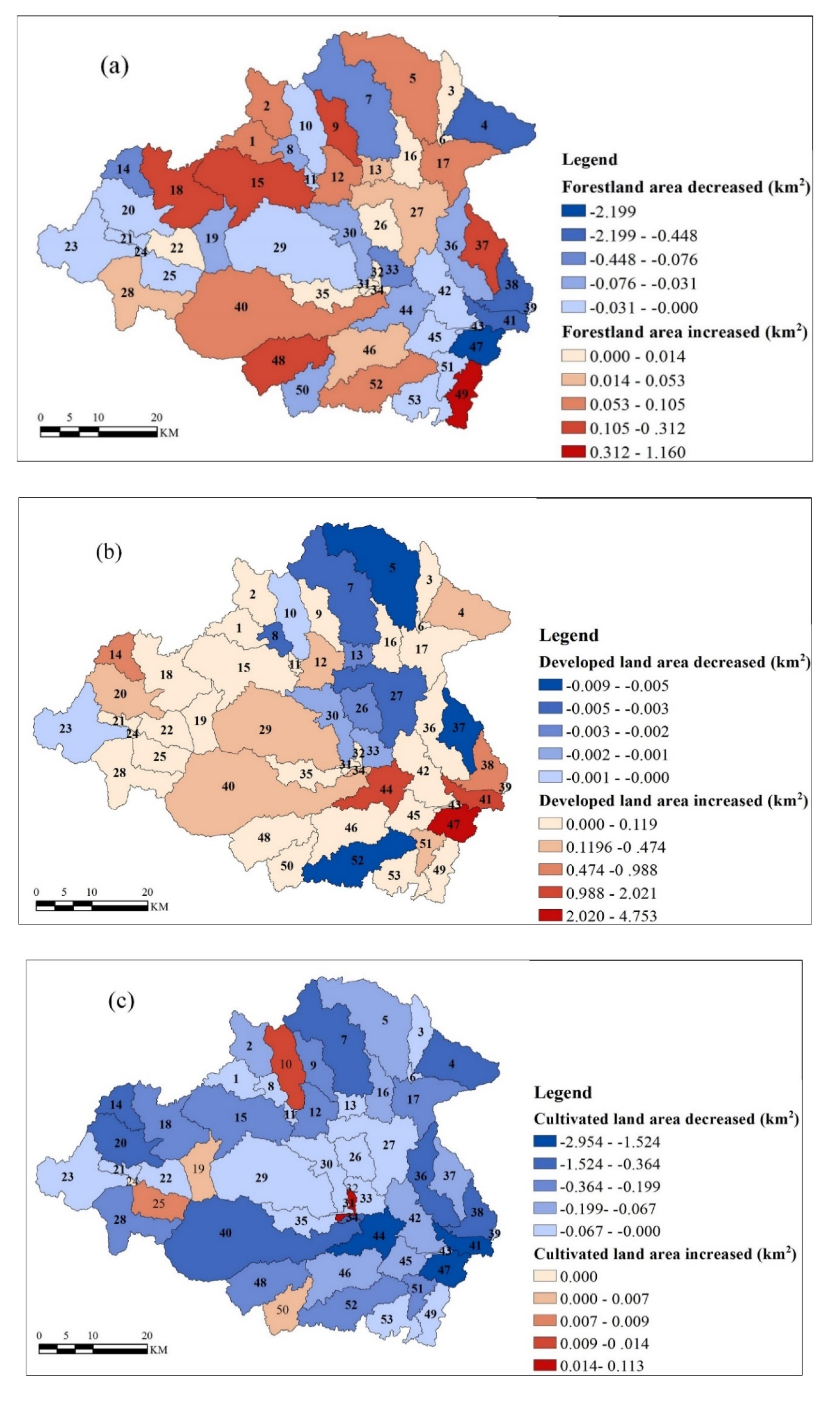


| Datasets | Resolution | Format | Source |
|---|---|---|---|
| Digital elevation model (DEM) | 17 × 17 m | Grid | Google Earth |
| Land use data | 30 × 30 m | Grid | Data Center for Resources and Environmental Sciences of Chinese Academy of Sciences, Institute of geographic sciences and natural resources research |
| Soil map | 1:50,000 | Shape file | Hunan Agricultural University |
| Soil attributes of different soil profile | point | xls | Hunan Provincial Soil Survey Project, Hunan Agricultural University |
| Weather data | Daily | xls | Hunan Provincial Key Laboratory of Meteorological Disaster Prevention and Reduction |
| Discharge data | Monthly | xls | Hunan Provincial Water Resources Department |
| Cultivated Land | Forestland | Grassland | Water Bodies | Developed Land | Unutilized Land | |||||||
|---|---|---|---|---|---|---|---|---|---|---|---|---|
| Area (km2) | % | Area (km2) | % | Area (km2) | % | Area (km2) | % | Area (km2) | % | Area (km2) | % | |
| 1990 | 1495.8 | 43.0 | 1882.3 | 54.1 | 19.2 | 0.6 | 37.4 | 1.1 | 46.7 | 1.3 | 0.1 | 0.0 |
| 2010 | 1482.8 | 42.6 | 1881.0 | 54.0 | 17.2 | 0.5 | 40.6 | 1.2 | 59.7 | 1.7 | 0.1 | 0.0 |
| Change | −13.0 | −0.9 | −1.2 | −0.1 | −2.0 | −10.4 | 3.1 | 8.4 | 13.0 | 27.9 | 0.0 | 0.0 |
| Parameter | Description | Initial Calibration Range | Sensitivity Ranking | Calibration Value |
|---|---|---|---|---|
| r_SOL_K.sol | Saturated hydraulic conductivity | (−1, 1) | 1 | 0.98 |
| r_CN2.mgt | SCS runoff curve number factor | (−1, 1) | 2 | −0.28 |
| r_SOL_AWC.sol | Available water capacity of the soil layer | (−1, 1) | 3 | 0.47 |
| v_HRU_SLP.hru | Mean gradient | (0, 1) | 4 | 0.96 |
| r_SOL_Z.sol | Soil layer depth | (−1, 1) | 5 | 0.67 |
| v_GW_REVAP.gw | Groundwater ”revap” coefficient | (0.02, 0.2) | 6 | 0.91 |
| v_GWQMN.gw | Shallow groundwater depth threshold value | (0, 5000) | 7 | 3553.07 |
| v_ALPHA_BF.gw | Base flow alpha factor | (0, 1) | 8 | 0.37 |
| v_GW_DELAY.gw | Groundwater hysteresis coefficient | (0, 500) | 9 | 105.82 |
| v_ESCO.hru | Soil evaporation compensation factor | (0, 1) | 10 | 1 |
| v_REVAPMN.gw | Threshold of evaporation in shallow aquifer | (0, 500) | 11 | 193.43 |
| Month | Precipitation Change (mm) | Temperature Change (°C) | Runoff Change Caused by Climate Change (∆RC) (m3/s) |
|---|---|---|---|
| 1 | −38.0 | 1.7 | −124.9 |
| 2 | −84.6 | 3.3 | −208.5 |
| 3 | −9.1 | −0.1 | −215.8 |
| 4 | 161.0 | −0.8 | 550.2 |
| 5 | 40.0 | 0.6 | 232.8 |
| 6 | 78.8 | −1.9 | 325.5 |
| 7 | −67.2 | 1.2 | −253.3 |
| 8 | 28.8 | 0.7 | −303.4 |
| 9 | −11.4 | 0.1 | 24.7 |
| 10 | −166.7 | −0.3 | −516.4 |
| 11 | −78.1 | −0.9 | −637.3 |
| 12 | 124.4 | 1.0 | 396.6 |
| Average | −1.8 | 0.4 | −60.8 |
| Month | Simulated Runoff (m3/s) | |||
|---|---|---|---|---|
| Scenarios S1 (Land Use in 1990, Climate in 1990) | Scenarios S2 (Land Use in 2010, Climate in 2010) | Scenarios S3 (Land Use in 1990, Climate in 2010) | Scenarios S4 (Land Use in 2010, Climate in 1990) | |
| 1 | 195.7 | 70.8 | 70.8 | 195.9 |
| 2 | 278.6 | 70.1 | 70.1 | 278.7 |
| 3 | 452.2 | 236.7 | 236.5 | 452.4 |
| 4 | 915.1 | 1466.0 | 1465.3 | 915.5 |
| 5 | 777.7 | 1010.6 | 1010.5 | 777.9 |
| 6 | 975.8 | 1301.7 | 1301.3 | 976.1 |
| 7 | 714.3 | 460.9 | 461.0 | 714.3 |
| 8 | 516.1 | 212.6 | 212.6 | 516.2 |
| 9 | 155.9 | 180.7 | 180.6 | 155.8 |
| 10 | 601.3 | 84.9 | 84.8 | 601.4 |
| 11 | 692.0 | 54.7 | 54.7 | 692.1 |
| 12 | 263.9 | 660.6 | 660.5 | 263.9 |
| Mean | 544.9 | 484.2 | 484.1 | 545.0 |
| Scenarios | Mean Monthly Runoff (m3/s) | Runoff Change ∆RL&C (m3/s) | Impact of Land Use Change | Impact of Climate Change | ||
|---|---|---|---|---|---|---|
| ∆RL (m3/s) | IL (%) | ∆RC (m3/s) | IC (%) | |||
| S1 | 544.9 | |||||
| S2 | 484.2 | −60.7 | ||||
| S3 | 484.1 | −60.8 | −100.22 | |||
| S4 | 545.0 | 0.1 | 0.20 | |||
© 2020 by the authors. Licensee MDPI, Basel, Switzerland. This article is an open access article distributed under the terms and conditions of the Creative Commons Attribution (CC BY) license (http://creativecommons.org/licenses/by/4.0/).
Share and Cite
Luo, L.; Zhou, Q.; He, H.S.; Duan, L.; Zhang, G.; Xie, H. Relative Importance of Land Use and Climate Change on Hydrology in Agricultural Watershed of Southern China. Sustainability 2020, 12, 6423. https://doi.org/10.3390/su12166423
Luo L, Zhou Q, He HS, Duan L, Zhang G, Xie H. Relative Importance of Land Use and Climate Change on Hydrology in Agricultural Watershed of Southern China. Sustainability. 2020; 12(16):6423. https://doi.org/10.3390/su12166423
Chicago/Turabian StyleLuo, Lanhua, Qing Zhou, Hong S. He, Liangxia Duan, Gaoling Zhang, and Hongxia Xie. 2020. "Relative Importance of Land Use and Climate Change on Hydrology in Agricultural Watershed of Southern China" Sustainability 12, no. 16: 6423. https://doi.org/10.3390/su12166423
APA StyleLuo, L., Zhou, Q., He, H. S., Duan, L., Zhang, G., & Xie, H. (2020). Relative Importance of Land Use and Climate Change on Hydrology in Agricultural Watershed of Southern China. Sustainability, 12(16), 6423. https://doi.org/10.3390/su12166423




